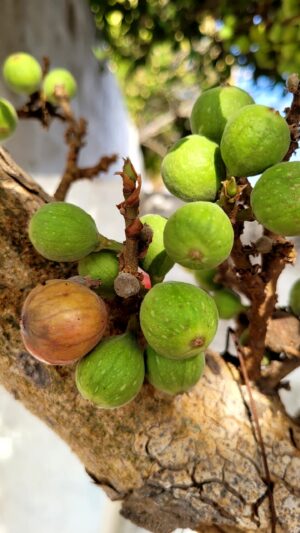
Gular shares the green of amra, resembling unripe small mangoes. As I sorted through the gular pickings, I noticed the variations in their size and firmness. Slicing the smaller ones was easy, while the larger ones presented a challenge; I realised then why my mother advised me to crush them in a mortar and pestle. Today, you can use a pressure cooker,simply one whistle,to render even the large gular soft. However, those who have eaten gular over the years are emphatic that the small ones taste better.
Gular, or cluster fig, is a cousin of the more popular and commonly eaten anjeer. It is found growing from the thick trunk of its tree,round and in bunches,in parks, by the road, next to rivers in subtropical regions. I had only ever heard of it in stories of its non-existence, of the mythical “lapoosen” (its name in my ancestral village of Sirauli in Uttar Pradesh) flowers that no one had ever seen. Recently, my mother and Shanti aunty, the domestic worker at my home, shared their tales of spotting gular, and how they like to cook it.
I followed my mother’s cooking technique and prepared this gular sabzi. Upon tasting it, I first noticed its leathery texture. Further bites revealed a slightly acidic and astringent flavour, unlike the sweetness of anjeer. The chewy texture of the fruit may be why many claim that it tastes and feels like mutton. Having never eaten mutton, I cannot confirm or deny this claim.
| Gular, small and unripe | 500 grams |
|---|---|
| Garlic paste | 1 tablespoon |
| Onion paste | 2 tablespoons |
| Mustard oil | 4 tablespoons |
| Cumin seeds | 2 teaspoons |
| Bay leaf | 2 |
| Turmeric powder | 2 teaspoons |
| Dried chillies, soaked | 10 grams |
| Coriander powder | 1 tablespoon |
| Salt | To taste |
What You Will Need
A pan, a mixer-grinder, and a mortar and pestle.
Instructions
Start by cutting the gular pieces into two. Then, thoroughly but gently clean the insides of the gular with water. This is to ensure that any small insects or debris trapped inside the fruit are removed.
Once cleaned, further crush the gular pieces into big chunks using a mortar and pestle.
Grind the turmeric powder, chillies, and coriander powder together to make a thick paste. This is the masala paste.
Shallow fry the pieces in 2 tablespoons of mustard oil. Sprinkle salt over the pieces as they fry.
Remove the gular pieces from the pan, and add the remaining oil to the pan. Let it heat up until it is smoking.
Once the oil is smoking, lower the flame.
Then, add the cumin seeds and bay leaves to the oil, followed by 1 tablespoon of the masala paste and let it cook until the aroma of raw masalas disappears.
Then, add the onion and garlic paste to the oil with some salt.
Fry the pastes until the oil separates from the paste. Now add the gular pieces and mix them well in the masala until the pieces are evenly covered with the masala mix.
After a few minutes, pour a ¾ glass of water. Cover and cook on low heat until the gular is soft and coated in masala.
Once the gular is cooked, you may sprinkle coriander leaves, garam masala, and a teaspoon of ghee, and serve hot.
Tips
To identify when the oil separates from the paste, keep an eye out for the oil visibly exuding from the masala paste mixture. The pastes, which are water heavy, will completely mix with the oil when added to the pan. As the water in the pastes evaporates, the paste will become dry enough to let go of the oil, causing the oil to ooze out from the sides and any gaps in the paste.
Priti Saxena pursued an MPhil in History from Jawaharlal Nehru University. Her curiosity about food history stems from the time she started cooking for her family. Her interest has since grown to include studying historical contexts, societal shifts, and cultural nuances of diverse cuisines. Her exploration has taught her that every meal has a story to tell, and that we need to keep them alive.
Read about Priti’s exploration of gular, its history and disappearance from our plates, here.
You must be logged in to rate this recipe.

Sign in with email

